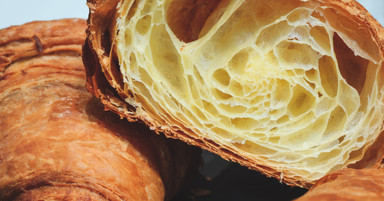Oct 2nd 2025
What Factors Affect the Flakiness of Bakery Pastries?
Peel back the golden top of a croissant and listen for the whisper of shattering layers. Bite in, and the shell gives way to warm, buttery folds that melt on your tongue. The inside is tender, the crust impossibly crisp, and every bite feels like it took hours to perfect.
All pastries should have this same undeniable pull—the kind that lingers in one’s memory long after the last crumb. But what factors affect the flakiness of bakery pastries?
Whether you’re turning out trays of Danishes or crafting seasonal galettes, flakiness isn’t a matter of luck. It’s the result of small decisions repeated precisely every day. Let’s break it down.
Ingredients and Proper Prep
Butter is where the flakiness begins. Not just any butter, though. You want high-fat, low-moisture options with minimal water content. European-style butter, for example, gives you cleaner layers and better separation during the bake.
How you prepare the butter matters, too. Chunks the size of a sugar cube create larger gaps in the dough, leading to those dramatic, pull-apart flakes that customers crave.
Flour choice deserves just as much attention. All-purpose flour may work in a pinch, but low-protein pastry flour creates a softer structure and prevents excess gluten development. That’s key in laminated dough, where elasticity can ruin your layering.
When it comes to water, be sure to weigh it. Even a 10 gram difference per batch can change your dough’s behavior under pressure.
Mixing and Lamination
The dough’s texture starts to form long before lamination. Overmixing encourages gluten, which makes dough tight and unyielding—two enemies of flakiness. An industrial dough mixer helps maintain a desired consistency. Mix the dough until it comes together, then stop; the folds will do the rest.
During lamination, timing between turns is everything. After each fold, rest the dough for 20 to 30 minutes in a cool environment. This step relaxes the gluten and keeps the layers from shrinking in the oven. Rushing this process leads to dense, chewy pastries.
Baking and Handling
Oven temperature should be high at the start—around 425 degrees Fahrenheit—to generate the steam needed for lift. After 10 to 12 minutes, you can lower the heat slightly to prevent overbrowning. Don’t crack the oven door too soon, though. Those first 12 minutes lock in structure, and interrupting the bake can deflate your hard-earned layers.
Once out of the oven, pastries need adequate airflow. Let them cool on wire racks for at least 20 minutes. Trapping steam underneath will soften that crisp exterior you worked so hard to achieve.
Invest Where It Counts
Understanding what factors affect the flakiness of bakery pastries can help you spot inefficiencies you didn’t even know you had and fix them. One small upgrade, like improving your mixing consistency, can reshape the quality of every batch.
If you’re looking for reliable equipment to support that level of precision, check out what we have to offer at Pro Restaurant Equipment. From KitchenAid and American Eagle Food Machinery to Ankarsrum, our lineup of commercial dough mixers helps bakeries like yours deliver that ideal, flaky finish every single time.

